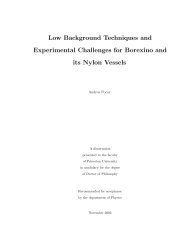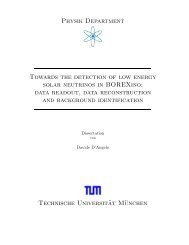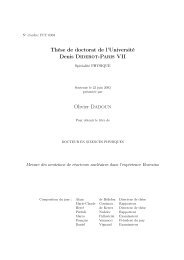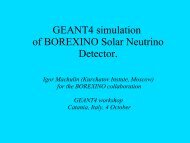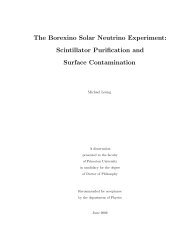Development of a Liquid Scintillator and of Data ... - Borexino - Infn
Development of a Liquid Scintillator and of Data ... - Borexino - Infn
Development of a Liquid Scintillator and of Data ... - Borexino - Infn
You also want an ePaper? Increase the reach of your titles
YUMPU automatically turns print PDFs into web optimized ePapers that Google loves.
2 The <strong>Borexino</strong> Experiment<br />
2.3 Detector Design<br />
2.3.1 The Main Detector<br />
The BOREXINO detector is being constructed in hall C <strong>of</strong> the Gran Sasso underground laboratory<br />
(LNGS) in Italy. The laboratory is shielded by an overburden <strong>of</strong> 3600 mwe which leads<br />
to a suppression <strong>of</strong> the cosmic muon flux by a factor <strong>of</strong> , down to a value <strong>of</strong> Ñ .<br />
The detector is designed in such a way as to reduce the external gamma ray background in<br />
the central fiducial volume to a level well below the expected solar neutrino signal. A detailed<br />
description <strong>of</strong> the BOREXINO detector can be found in [Ali01]. A sketch <strong>of</strong> the detector is<br />
shown in fig. 2.6.<br />
The active part <strong>of</strong> the detector is an unsegmented volume <strong>of</strong> 300 tons <strong>of</strong> liquid scintillator,<br />
contained in a thin (0.1 mm) spherical nylon vessel <strong>of</strong> diameter 8.5 m (Inner Vessel). The<br />
scintillator consists <strong>of</strong> the solvent pseudocumene (PC, 1,2,4 trimethylbenzene) with 1.5 g/l<br />
PPO (3,5 diphenyloxazole) added as fluor.<br />
The scintillation light is observed by 2200 8” diameter photomultiplier tubes (PMTs) mounted<br />
on the inside surface <strong>of</strong> a stainless steel sphere with a diameter <strong>of</strong> 13.7 m. 1800 PMTs are<br />
equipped with light concentrators for an efficient collection <strong>of</strong> the scintillation light from the<br />
Inner Vessel. Signals from the 400 remaining PMTs without concentrators will be used for<br />
distinguishing muon tracks producing Cerenkov light in the buffer region from events inside<br />
the scintillator. The three dimensional arrangement <strong>of</strong> the photomultipliers allows the position<br />
<strong>of</strong> the neutrino interactions within the detector volume to be reconstructed using the timing<br />
information <strong>of</strong> the triggered PMTs. Thus, a fiducial volume <strong>of</strong> 100 tons <strong>of</strong> scintillator (radius<br />
3 m) can be defined by s<strong>of</strong>tware cuts to reduce the external background.<br />
The volume between the Inner Vessel <strong>and</strong> the stainless steel sphere is filled with 1000 m <strong>of</strong> a<br />
buffer liquid which serves as shielding against radioactive background from the outer detector<br />
parts. This buffer liquid has to fulfill several requirements: it should be optically transparent to<br />
the fluorescence emission <strong>of</strong> PPO (i.e. it should not absorb the scintillation light from the active<br />
scintillator volume), <strong>and</strong> it should not emit fluorescence light itself, as this would lead to very<br />
high counting rates mainly due to the background from the PMTs. Ideally, the refractive index<br />
<strong>of</strong> the buffer should match that <strong>of</strong> the scintillator. The density <strong>of</strong> the buffer liquid should be<br />
very close to the density <strong>of</strong> the scintillator to minimize the buoyancy-induced stress on the thin<br />
nylon vessel (thickness only 0.1 mm). The buffer liquid was chosen to be pseudocumene with<br />
the addition <strong>of</strong> 5 g/l DMP (dimethylphthalate) as a quencher to suppress the fluorescence in the<br />
buffer PC by a factor <strong>of</strong> 20 [Che99]. A second nylon barrier with a diameter <strong>of</strong> 10.5 m should<br />
prevent the Rn atoms emanating from the steel, PMTs <strong>and</strong> concentrators from getting close<br />
to the active scintillator volume.<br />
The external steel tank with a height <strong>of</strong> 17 m <strong>and</strong> 18 m diameter filled with deionized water<br />
provides a final shield against gamma rays <strong>and</strong> neutrons from the surrounding rocks. The<br />
thickness <strong>of</strong> the water buffer is 2 m, except at the bottom where it is only 1 m. Steel plates<br />
under the floor <strong>of</strong> the tank provide the equivalent <strong>of</strong> 1 m <strong>of</strong> water shielding. 200 phototubes<br />
24



